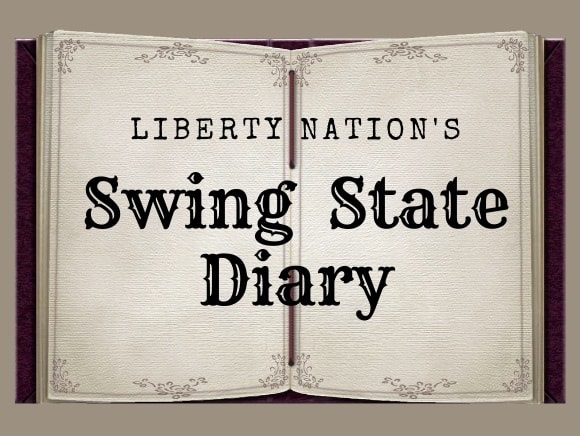
As the all-important presidential election approaches, voters of all stripes are looking for real information. Too often, audiences are presented with the results of a single poll and 500 words of self-serving opinion. At Liberty Nation, we strive to offer not just the latest facts and figures, but also in-depth analysis.
This week’s Swing State Diary looks at Minnesota, a Democrat stronghold that may be in play and more precarious than media pundits and pollsters would have you believe.
Is Minnesota a swing state? Well, yes. Although the state has not voted for a Republican since Richard Nixon in 1972, there is a good chance that 2020 could end the almost 50-year dry spell for the GOP.
As a potential pick-up for the Republican Party, the Land of 10,000 Lakes has long been off the radar; even Ronald Reagan failed to win it in his 1984 49-state landslide. So why is the Trump campaign eyeing it so keenly? Does the president think he sees something others have missed?
Making an Effort
The New York Times reported in October 2019 that the Trump campaign “is planning to pour tens of millions of dollars into the Minnesota operation, compared with the $30,000 the Trump campaign spent on the state last cycle. The campaign already has 20 paid staff members in the state, and expects to expand to 100.”
Imagine that for a moment. If political spending really does turn into actual votes (and if it didn’t, why would they do it?), how much more of an impact will millions of dollars have? It is clear that in 2016, then-candidate Trump assumed that he wouldn’t get anywhere near the votes needed to take this Democratic Party bastion, and so spent very little cash and time there until the last minute.
Of the 87 counties available, Trump won 78. There are certain large population counties that are unlikely to have a change of heart, so if the president wants to get those ten Electoral College votes on offer, he needs to tighten up his game and try to maximize his pull in the smaller counties. The Twin Cities region (Minneapolis and St. Paul) was handily won by Clinton, and these account for around 230,000 extra votes – Trump lost this state by less than 45,000 votes.
In December 2019, Jared Kushner, Trump campaign manager Brad Parscale, and senior officials gave a presentation in which they outlined their plan:
“New math: Tiny counties traditionally overlooked by candidates helped deliver Trump his 2016 victories in states like Wisconsin (where the smallest 48 counties = 22% of the statewide vote) and Pennsylvania (where the 45 smallest counties = 20% of the statewide vote).”
Third-Party Power Plays
One of the reasons that Trump failed to win Minnesota was because of strong third-party candidates. Remember, Clinton won by just 1.5%. Gary Johnson, standing for the Libertarian Party, racked up an impressive 112,972 votes, 3.84% of the total, and between Evan McMullin and Jill Stein, there was a pool of more than 90K (over 3%). These were all relatively strong candidates who received a lot of press.
 This time around, the battle is between Trump and quite literally anyone else the Democratic Party puts forward. Third-party candidates were a pleasant distraction in 2016 that the media enjoyed telling the nation were more popular than Donald Trump; that veneer is gone. All parties now accept that this is a battle to the (electoral) death for their chosen gladiator, and all the media is right behind them cheering on the blood sport.
This time around, the battle is between Trump and quite literally anyone else the Democratic Party puts forward. Third-party candidates were a pleasant distraction in 2016 that the media enjoyed telling the nation were more popular than Donald Trump; that veneer is gone. All parties now accept that this is a battle to the (electoral) death for their chosen gladiator, and all the media is right behind them cheering on the blood sport.
In fact, the only third-party upset in 2020 could be if the Green Party ends up with a contested convention. Jesse Ventura, former wrestler and Minnesota governor has indicated that if a clear candidate is not forthcoming, he would consider throwing his hat in the ring. Ventura aced the 1998 gubernatorial race, winning over 700K votes, but that was long ago and far away.
The Polling Action
Right now, Joe Biden is beating President Trump by five points in Minnesota. This seems a convincing lead, and even the betting markets give the eventual Democratic nominee the edge. But looking back at 2016 may provide us with a little more insight.
Of the five Minnesota polls closest to 2016 election day, all but one gave Hillary Clinton a comfortable win, the outlier being a Gravis poll that predicted 43% each. If you make an average of these polls, it suggests Clinton should have won by roughly 8% – the final result was, of course, just 1.5%. That’s a 6.5% difference between polling and reality.
It’s worth considering this five-point lead in light of the facts that:
- Trump is spending millions of dollars on this cycle.
- The Trump campaign isn’t just writing Minnesota off in 2020.
- There is no strong third-party action.
- The Trump campaign has a gameplan for winning smaller counties.
- There appears to be an enthusiasm gap for Mr. Biden.
Taken together, it seems that President Trump has a better than average chance of winning a True Blue Democratic stronghold. Whether the ten Electoral College votes is enough to make a final difference remains to be seen, but it is quite clear that Minnesota is a prize in play and that both sides are desperate to claim it.
What Liberty Nation Authors Say
LibertyNation.com Washington Political Columnist Tim Donner believes Minnesota has been in Trump’s cross-hairs from the moment he learned of his narrow defeat there in 2016:
“Trump is trying to capitalize on the heartland zeitgeist that lifted him to victory four years ago. He felt the love in neighboring Wisconsin, Ohio and throughout the midwest, and it makes sense that his campaign would dedicate serious resources to the land of ten thousand lakes. Trump has in view a generational change in the electoral map, transforming the entire heartland from blue to red.”
We leave the final word to Sarah Cowgill, LN’s National Columnist well familiar with heartland politics:
“Here is how the president can take the state in 2020: He must energize the party (expect a rally) to get out the vote. Four years ago, 75% of eligible voters turned out in the state. That’s a huge turnout – the largest in the nation. And heck, with Democrats wanting to stay home instead of head to the polls, Minnesota is winnable and very much in play.”
~
Read more from Mark Angelides.




